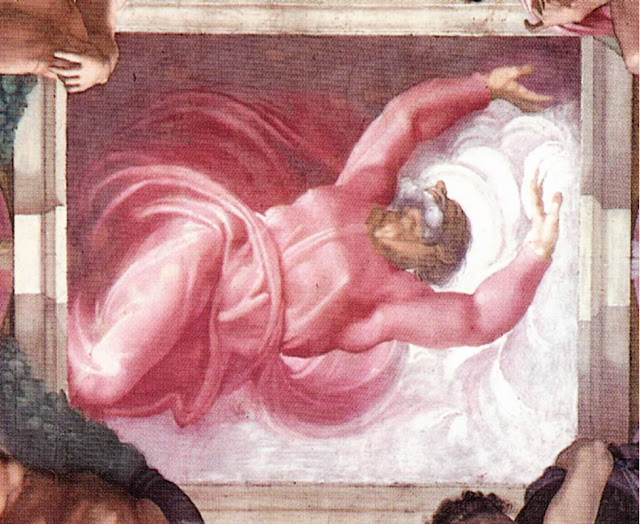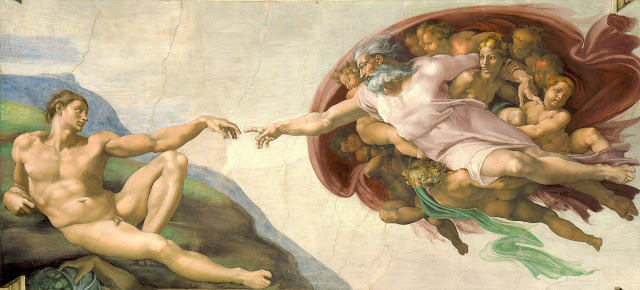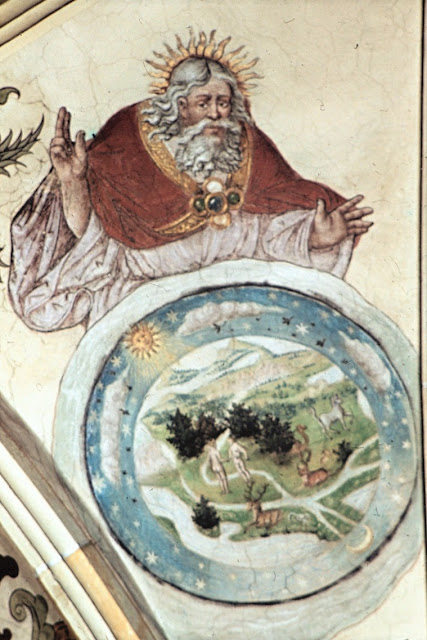 |
Barthel Bruyn, Vanitas
Dutch, died 1555
Otterlo, Krueller-Moeller Museum
The text reads "Everything falls into death; death is the ultimate limit of things"
|
“Brothers and sisters:
We are ambassadors for Christ,
as if God were appealing through us.
We implore you on behalf of Christ,
be reconciled to God.
For our sake he made him to be sin who did not know sin,
so that we might become the righteousness of God in him.
Working together, then,
we appeal to you not to receive the grace of God in vain.
For he says:
‘In an acceptable time I heard you,
and on the day of salvation I helped you.’
Behold, now is a very acceptable time;
behold, now is the day of salvation.”
(2 Corinthinas 5:20-21 and 6:1-2)
Second Reading from the Mass for Ash Wednesday*
“Now is the time, now is the day” St. Paul tells us in the portion of Second Corinthians that is read in Ash Wednesday Masses as we commence the annual observance of the penitential season of Lent. St. Paul is reminding us, quite passionately, that we must not waste time and wait for “tomorrow” to seek forgiveness and reform our lives. The time is now, for “tomorrow” may not come.
This same sense of the swift passage of time and the terrible instability of life inform a type of painting that appeared during a relatively short time in the history of Western art. These are in the genre of still life paintings known as the “Vanitas”.
 |
Jacob de Gheyn II, Vanitas
Dutch, 1603
New York, Metropolitan Museum
The inscription above the mirror reads "Human Vanity" |
Vanitas (vanity) paintings began to appear in the 16th century, but reach their peak numbers during the 17th century and disappear during the 18th century. Sometimes they are also called 'memento mori' (remember death) paintings.
 |
Memento Mori
Flemish, c. 1530
The Hague, Mauritshuis Museum |
They were popular throughout northern Europe, including the Netherlands, France, England and Spain. Therefore, they cut across the Catholic/Reformed religious divide of European society at the time.
The era in which they were popular was one filled with European wars (wars of religion, the Thirty Years War, the wars of Louis XIV), epidemics (the Plagues of Seville, London, Vienna) and "the thousand natural shocks that flesh is heir to".
Early images were fairly simple, often consisting of little more than a skull and extinguished candle and, possibly, an inscription attesting to the fragility of things (see above). Sometimes they could be brutally explicit, as in the print below. Here, the figure of a beautiful woman (above the waist) is revealed to be a rotten skeleton (below). She is framed by two vertical objects. To her right is a tall crucifix, with a banner around the shaft, bearing the words "O crux fidelis inter omnes Arbores" ("O faithful cross among all trees"). On her left is a palm tree with a banner bearing the words "Justus ut palma florebit in Domo Domini" extended on a floating banner by the words "Nemini parco qui vivit in orbe" .
 |
Luca Bertelli, Vanitas
Italian, 1578
Amsterdam, Rijksmuseum |
The first phrase is a quotation from Psalm 92:13-14 "The just shall flourish like the palm tree...in the house of the Lord". The second is more difficult to identify, but appears to be an directed at us. It can be translated as "I spare no one who lives in the world."1 Its proximity to the crowned heads of a pope, a king and an emperor appears to be an illustration of the point of the quotation and the "I" who spares no one is Death. The quotation is associated with the late medieval Dance of Death motif, which is a precursor to the Memento Mori and Vanitas themes.
At her feet is another banner that reads: "Ne te discipiat mulier formosa, superne ossa subornata, faetida sola latent" . This can be translated as: "Do not let a beautiful woman distract you, the bones cover the rottenness that hides below." She is surrounded by a border of skeletal arms crossed below skulls, a skull lies at the foot of the crucifix and the crowned heads lie at the foot of the palm tree, on their way to becoming skulls.
The message of this print could hardly by more specific. Glory and beauty are fleeting, what counts is one's repentance.
Over time the harshness became tempered, other items were added. Flowers, with their transient beauty, were obvious early additions.
Later on, the scenes became more and more crowded with objects of all kinds: musical instruments, books, drawings, crowns (both regal and papal), armor, clocks, money, mirrors, scientific instruments, statues, objects made of glass, bubbles, etc. The mood became lighter and the fearsome Memento Mori began to transmute into the wistful moment of nostalgia, of remembrance of happier moments, of reflection on the transience of all things, rather than of fear of future judgment.
 |
Pieter Clauszoon_Vanitas with the Spinario
Dutch, 1628
Amsterdam, Rijksmuseum |
 |
Pieter Clauszoon_Vanitas with Tulip
Dutch, c. 1630
Otterlo, Kroeller-Mueller Museum |
 |
Vincent Laurenzoon van der Vinne I, Vanitas
Dutch, post-1649
Paris, Musée du Louvre
The inclusion of the crown and the portrait of King Charles I of England references the king's execution in January 1649. |
 |
Simon Renard de Saint-Andre, Vanitas
French, 1650
Lyons, Musée des Beaux-Arts
|
|
 |
Pieter Boel, Vanitas
Flemish, 1663
Lille, Musée des Beaux-Arts |
Most often these works are devoid of people. However, very occasionally they are populated, though not always by the living. In some, the skull is replaced by a complete skeleton (related to the skeletons that often appear during the same time period in tomb sculpture).
The greatest of these is the painting in the Hospital de la Caridad in Seville, Spain by the painter Juan de Valdes-Leal. The skeleton, who is Death, is armed with scythe, shroud and coffin. His bony hand extinguishes a candle and simultaneously points to an inscription that translates as "in the twinkling of an eye", a reminder of how quickly death devours earthly achievements.
 |
Juan de Valdes-Leal, Vanitas Spanish, c. 1670-1672 Seville, Hospital de la Caridad |
Occasionally an artist painted a self-portrait of himself as part of a Vanitas composition. Initially, the artists painted themselves as tiny reflections in shiny surfaces within the assemblage of still life, such as metal or glass objects. However, as the17th century advanced, some began to paint themselves into the picture, as living examples of transience. There is some debate about the meaning of these curious self-portraits. Are they perhaps painted as an act of penitence? Or are they clever demonstrations of the artist's power to overcome transience through his or her art?2
 |
Clara Peeters, Still Life with Flowers and Gilded Objects
Dutch, 1612
Karlsruhe, Kunsthalle
Here the artist's self-portrait is in the form of several identical teeny reflections in the tall cup on the right. See the detail below. |
 |
Clara Peeters, Detail of Still Life with Flowers and Gilded Objects Showing the tiny self-portraits of the artist at her easel reflected in the shiny surface of the decorative knobs on the cup. |
 |
Pieter Clauszoon, Vanitas with Glass Ball
Dutch, 1628
Nuremberg, Germanisches Nationalmuseum
The self-portrait in this work is a reflection in the glass ball. |
 |
David Bailly, Self-Portrait with Vanitas Symbols
Dutch, 1651
Leiden, Stedelijk Museum De Lakenhal
In this picture the artist not only paints himself, he may also be playing with the idea of the transience of time. The relevant quotation here is "Vanity of vanities, all is vanity". It appears, in Latin, on the sheet of paper drooping from the table at the far right. It has been proposed that the actual self-portrait is the painted minature being held by the artst who is self-portrayed as a young man. By painting himself in two stages of life is he commenting on the transience of existence or is he demonstrating that his artistic skill can transcend time? |
 |
Edwaert Collier, Self-Portrait with Vanitas
Dutch, 1684
Private Collection
On the right of this picture is a sheet of paper which reads "Vita Brevis, Ars Lunga" (Life is short, art is long"). This spells out the ambiguity of some of these self-portrait images, reminders of both mortality and of the power of art. |
Angels sometimes appeared as well. The Spanish painter Antonio de Pereda included angels in some of his works. In his Allegory of Vanity (1634), the angel holds a miniature portrait of the Emperor Charles V. The angel balances it on a globe, and points to a location which appears to be somewhere off the northern coast of South America. Since Charles was long dead when the picture was painted, this may be a reference to the fact that Charles’ dominion over the New World availed him nothing against death.
 |
Antonio de Pereda, Vanitas
Spanish, 1634
Vienna, Kunsthistorisches Museum |
Similarly, the angel in the Knight’s Dream holds a banner which proclaims in Latin 'Eternally stinging, it flies and kills quickly”. “It” is the bow and arrow drawn in the center of the banner, a reminder that death can come quickly and make the items of vanity spread on the table in front of the dozing knight utterly worthless.
 |
Antonio de Pereda, The Knight's Dream
Spanish, 1655
Madrid, Academia Real |
The meaning behind all these paintings is that of St. Paul, now is the time to repent.
© M. Duffy, 2012, update 2023
__________________________
* Excerpts from the Lectionary for Mass for Use in the Dioceses of the United States of America, second typical edition © 2001, 1998, 1997, 1986, 1970 Confraternity of Christian Doctrine, Inc., Washington, DC. Used with permission. All rights reserved. No portion of this text may be reproduced by any means without permission in writing from the copyright owner.
1. I would like to thank the anonymous reader who sent me this translation. It made much more sense than my own attempts. And with that corrected information I was able to find more information about the quotation.


















,%20c.%201400_BNF_Francais%203,%20fol.%203v+earth.jpg)
,%20c.%201400_BNF_Francais%203,%20fol.%203v.jpg)
,%20c.%201400_BNF_Francais%203,%20fol.%204.jpg)
,%20c.%201400_BNF_Francais%203,%20fol.%204v.jpg)
,%20c.%201400_BNF_Francais%203,%20fol.%205.jpg)
,%20c.%201400_BNF_Francais%203,%20fol.%205v.jpg)
,%20c.%201400_BNF_Francais%203,%20fol.%206.jpg)
,%20ca.%201400_BNF_Francais%203,%20fol.%206v.jpg)
,%20ca.%201400_BNF_Francais%203,%20fol.%207r.jpg)
,%20ca.%201400_BNF_Francais%203,%20fol.%207r2.jpg)
,%20ca.%201400_BNF_Francais%203,%20fol.%208r.jpg)
,%20ca.%201400_BNF_Francais%209,%20fol.%204.jpg)
,%20ca.%201400_BNF_Francais%209,%20fol.%204v.jpg)
,%20ca.%201400_BNF_Francais%209,%20fol.%205.jpg)
,%20ca.%201400_BNF_Francais%209,%20fol.%205v.jpg)
,%20ca.%201400_BNF_Francais%209,%20fol.%206r.jpg)
,%20ca.%201400_BNF_Francais%209,%20fol.%206v.jpg)
,%20ca.%201400_BNF_Francais%209,%20fol.%207v.jpg)
,%20ca.%201400_BNF_Francais%209,%20fol.%208r.jpg)
,%20ca.%201400_BNF_Francais%209,%20fol.%208v.jpg)
,%2015th%20Century_Paris,%20BNF_MS%20Latin%209471,%20fol.%201f.jpg)
,%2015th%20Century_Paris,%20BNF_MS%20Latin%209471,%20fol.%201v.jpg)
,%2015th%20Century_Paris,%20BNF_MS%20Latin%209471,%20fol.%202v.jpg)
,%2015th%20Century_Paris,%20BNF_MS%20Latin%209471,%20fol.%203v.jpg)
,%2015th%20Century_Paris,%20BNF_MS%20Latin%209471,%20fol.%204v.jpg)
,%2015th%20Century_Paris,%20BNF_MS%20Latin%209471,%20fol.%205v.jpg)
,%2015th%20Century_Paris,%20BNF_MS%20Latin%209471,%20fol.%206v.jpg)
,%2015th%20Century_Paris,%20BNF_MS%20Latin%209471,%20fol.%207v.jpg)

,%201447-1455_BNF_Latin%204915,%20fol.21v.jpg)
,%201447-1455_BNF_Latin%204915,%20fol.22.jpg)
,%201447-1455_BNF_Latin%204915,%20fol.23r.jpg)
,%201447-1455_BNF_Latin%204915,%20fol.23v.jpg)
,%201447-1455_BNF_Latin%204915,%20fol.24r.jpg)
,%201463_BNF_Francais%2050,%20fol.%2016v.jpg)
,%201463_BNF_Francais%2050,%20fol.%2017v.jpg)
,%201463_BNF_Francais%2050,%20fol.%2018.jpg)
,%201463_BNF_Francais%2050,%20fol.%2019.jpg)
,%201463_BNF_Francais%2050,%20fol.%2020.jpg)
,%201463_BNF_Francais%2050,%20fol.%2020v.jpg)
,%201463_BNF_Francais%2050,%20fol.%2021r.jpg)






,%201542_BNF_Latin%208880,%20fol.%20182v-2%20(2).png)






.jpg)

.gif)